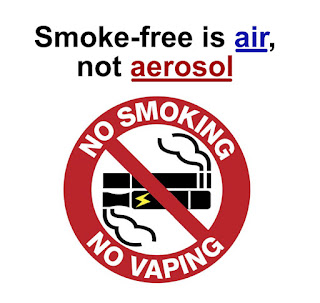Thursday, December 24, 2020
Why are teens smoking and vaping?
Monday, October 12, 2020
Smoke-free air is aerosol-free. Don't be fooled.
Tobacco smoke is a chemical aerosol, composed of gaseous and particulate matter. It is also toxic and carcinogenic, and up to 70 carcinogens have been identified among its thousands of chemicals.
Electronic smoking devices (ESD) such as electronic nicotine delivery systems (ENDS) and heated tobacco products (HTP) also emit similar chemical aerosols. They do not emit simple water vapour.
In fact, ESDs emit many of the same toxic chemicals in tobacco smoke (as well as new ones); albeit studies seem to show a lesser concentration of these toxicants and carcinogens.
ESD proponents, including tobacco companies and their vociferous lap dogs, publicly claim that ESD use is less harmful (even "95% less harmful") than cigarette smoking, that cigarette smokers can "quit" smoking by switching to ESDs, and that smokers have a right to access these "safer" alternatives to cigarettes.
The "95% less harmful" factoid has been debunked for years, but even if it were true, is there such a thing as a "less harmful" poison or cancer? Is it okay to jump from the 5th floor rather than the 100th floor of a building?
The truth is that none of the manufacturers of these ESDs can or will claim that their products are safe or harmless, and so far, none of them have registered their products as smoking cessation devices in any country in the world. Doesn't that make you wonder why?
In its application to the US FDA, Philip Morris even gave an "important warning" - "It has not been demostrated that switching to the IQOS system reduces the risk of developing tobacco-related diseases compared to smoking cigarettes."
Source: FDA does not rule that IQOS reduces tobacco-related harm, yet PMI still claims victory
https://exposetobacco.org/wp-content/uploads/STP054_FDA_IQOS_Brief_v3.pdf
So remember:
Wednesday, July 29, 2020
WHO's statement on heated tobacco products and the US FDA decision regarding IQOS is spot on
The full statement is reproduced below and also available on the WHO website: https://www.who.int/news-room/detail/27-07-2020-who-statement-on-heated-tobacco-products-and-the-us-fda-decision-regarding-iqos
WHO statement on heated tobacco products and the US FDA decision regarding IQOS
27 July 2020WHO takes this opportunity to remind Member States that are Parties to the WHO Framework Convention of Tobacco Control (FCTC) of their obligations under the Convention. Heated tobacco products are tobacco products, meaning that the WHO FCTC fully applies to these products. (Decision FCTC/COP8(22)) Specifically, Article 13.4(a) obliges Parties, to prohibit "all forms of tobacco advertising, promotion and sponsorship that promote a tobacco product by any means that are false, misleading or deceptive or likely to create an erroneous impression about its characteristics, health effects, hazards or emissions."
WHO reiterates that reducing exposure to harmful chemicals in Heated Tobacco Products (HTPs) does not render them harmless, nor does it translate to reduced risk to human health. Indeed, some toxins are present at higher levels in HTP aerosols than in conventional cigarette smoke, and there are some additional toxins present in HTP aerosols that are not present in conventional cigarette smoke. The health implications of exposure to these are unknown.
On 7 July 2020, the US FDA authorized the marketing of a heated tobacco product, the IQOS Tobacco Heating System, under the Federal Food, Drug and Cosmetic Act. This Act requires pre-market authorization of new tobacco products before they can be placed on the US market.
The US FDA statement noted that, “Even with this action, these products are not safe nor “FDA approved“. The exposure modification orders also do not permit the company to make any other modified risk claims or any express or implied statements that convey or could mislead consumers into believing that the products are endorsed or approved by the FDA, or that the FDA deems the products to be safe for use by consumers.”
The US FDA authorization rejected claims that the use of the product is less harmful than another tobacco product or reduces risks to health. The FDA orders also require the company to monitor youth awareness and use of the products to help ensure that the marketing of the MRTPs does not have unintended consequences for youth use. The company must also keep the FDA apprised of efforts to prevent youth access and exposure.
Given that health may be affected by exposure to additional toxins when using HTPs, claims that HTPS reduce exposure to harmful chemicals relative to conventional cigarettes may be misleading.
Moreover, the relevant orders grant a temporary market authorization within the US and are based on factors specific to the US, which is not a Party to the WHO Framework Convention on Tobacco Control (WHO FCTC).
All tobacco products pose risks to health and WHO urges full implementation of the WHO FCTC. Rigorous implementation will support quit attempts and reduce initiation by non-users of tobacco products, especially the young. WHO recommends cessation of all tobacco use with interventions, such as brief advice from health professionals, national toll-free quit lines, nicotine replacement therapies and cessation interventions delivered via mobile text messaging.

